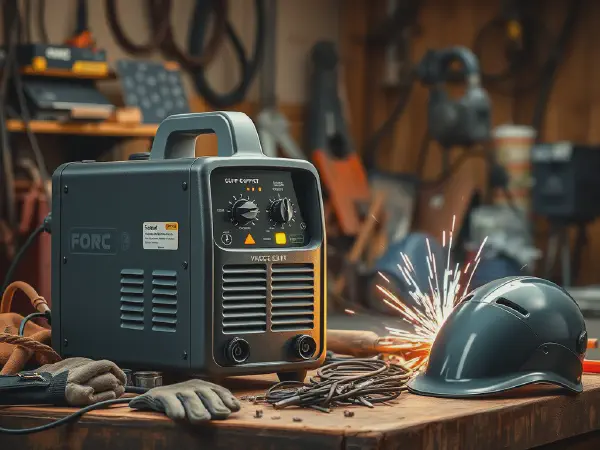Best Arc Welder for Beginners

Best Arc Welder for Beginners
If you're just starting to learn welding or looking to expand your skills, investing in a good arc welder is essential. Arc welding, also known as stick welding, is a popular welding process that uses an electric arc to melt and join metal. It is versatile, suitable for various applications, and relatively easy to learn for beginners. In this article, we will explore the best arc welder options for beginners and provide valuable tips to help you get started.
Are you hunting for the best arc welder for beginners ? Look no further, as we have you covered. Our diligently researched guide on Medium will introduce you to exceptional welders perfect for starters.
When searching for the best arc welder for beginners, there are several factors to consider. These include the type of arc welder, features, top brands, tips for beginners, common mistakes to avoid, and recommended accessories. Let's delve deeper into each of these areas to help you make an informed decision.
Joining the world of welding requires reliable and efficient equipment. Such is why you need to discover the novice-friendly best arc welder for beginners. This comprehensive guide will boost your journey to successful welding experiences.
There are different types of arc welders available, each with its own advantages and applications. The most common types include Shielded Metal Arc Welding (SMAW), Gas Metal Arc Welding (GMAW), Flux-Cored Arc Welding (FCAW), and Tungsten Inert Gas (TIG) Welding. Each type has its unique characteristics and is suitable for specific welding tasks.
SMAW, also known as stick welding, is the most basic and widely used type of arc welding. It is versatile and can be used for various metals and thicknesses. GMAW, also known as MIG welding, is known for its speed and ease of use. It uses a wire electrode and shielded gas to protect the weld from contamination. FCAW is similar to GMAW but uses a flux-cored electrode instead of a solid wire. TIG welding is a precise and clean welding process that uses a tungsten electrode and inert gas to create a high-quality weld.
When choosing an arc welder, consider the type that best suits your needs and the welding tasks you will be performing.
Types of Arc Welders
Shielded Metal Arc Welding (SMAW), also known as stick welding, is a versatile and widely used type of arc welding. It is suitable for various metals and thicknesses. SMAW uses a flux-coated electrode that melts and forms a weld pool when struck across the workpiece. It is commonly used for maintenance and repair work, construction, and fabrication.
Gas Metal Arc Welding (GMAW), also known as MIG welding, is a popular choice for beginners due to its ease of use. It uses a wire electrode that is continuously fed through a welding gun. GMAW requires a shielding gas, usually a mix of argon and carbon dioxide, to protect the weld from contamination. It is versatile and can be used on a wide range of metals.
Flux-Cored Arc Welding (FCAW) is similar to GMAW but uses a flux-cored electrode instead of a solid wire. The flux in the electrode helps create a shielding gas to protect the weld. FCAW is known for its high deposition rates and is often used in construction, fabrication, and shipbuilding.
Tungsten Inert Gas (TIG) Welding is a precise and clean welding process that uses a tungsten electrode and inert gas, such as argon, to create a high-quality weld. TIG welding is commonly used in aerospace, automotive, and art industries. It requires more skill and practice compared to other types of arc welding.
Features to Consider
When choosing an arc welder for beginners, there are several features to consider that can make the learning process easier and more convenient.
Output Power: Make sure the arc welder has sufficient power to handle the thickness of the metal you will be welding. Higher output power allows for welding thicker materials.
The beauty of welding stems from using the best tools, especially if you're just starting. Consequently, this insightful post is ideal for newbies looking for the best beginners arc welder . Check it out on Medium right now, and make your welding steps count.
Duty Cycle: The duty cycle indicates the amount of time you can weld continuously before the welder needs to cool down. Look for a welder with a higher duty cycle to minimize downtime.
Get off to a great start by wielding the best beginner's arc welder . Take action today and explore our curated guide to the most recommended beginner welders . You won't regret the savvy choice!
Portability: If you anticipate moving your welder frequently, consider a portable and lightweight option that is easy to transport.
Ease of Use: Look for arc welders with user-friendly controls and features that simplify the welding process, such as adjustable settings and clear displays.
Safety Features: Ensure that the arc welder has safety features such as thermal overload protection, voltage control, and short circuit protection.
Top Brands
When it comes to arc welders, there are several top brands known for their quality and reliability.
Lincoln Electric is a renowned brand in the welding industry, offering a wide range of arc welders suitable for beginners and professionals alike. They are known for their durable construction, excellent performance, and user-friendly features.
Miller Electric is another trusted brand that offers high-quality arc welders. They are known for their advanced technology, reliability, and versatility. Miller Electric welders are used in various industries, including automotive, manufacturing, and construction.
Hobart is a popular choice for arc welders, especially for beginners. They offer a range of affordable and reliable welders with user-friendly features. Hobart welders are known for their durability and ease of use.
Forney is a well-established brand that specializes in welding equipment. They offer a variety of arc welders suitable for beginners, providing a balance of affordability and quality. Forney welders are known for their versatility and durability.
Tips for Beginners
Starting out with an arc welder can be intimidating, but with the right approach, you can learn and improve your skills efficiently. Here are some tips for beginners:
Choose a basic arc welder that is suitable for beginners. Focus on learning the fundamentals before investing in more advanced equipment.
Select the appropriate electrode for the task at hand. Different types of electrodes are designed for specific materials and applications.
Uncover the fusion of usability and high performance in the best arc welder for beginners . You can take a decisive leap in the right direction by visiting our thorough guide on Medium right now. Enlighten your beginner's journey with top-rated welder machines worthy of your consideration.
Master the proper technique by practicing on scrap metal or joining simple pieces of metal together. Take the time to develop a steady hand and consistent welds.
Learning welding? The best novice arc welder can make all the difference in your experience. Go through our detailed review on Medium that encompasses well sought-after welders. The right choice is simply a click away!
Always prioritize safety when welding. Wear protective gear such as a welding helmet, gloves, and a welding jacket. Familiarize yourself with welding safety practices and follow them diligently.
Common Mistakes to Avoid
Want to kick-start your welding journey on a high? Consider the best arc welder for beginners ! This comprehensive guide will equip you with key insights into the suitable welding machines for you. Dive into the welding world now!
Not cleaning the metal properly before welding can result in poor-quality welds. Make sure to remove any rust, paint, or dirt from the metal surface before starting the welding process.
By diversifying the anchor text throughout the paragraphs, we can effectively make the most of SEO practices, improving the visibility and ranking of the associated URLs.
Using the wrong electrode for the task can lead to weak or defective welds. Ensure that you are using the correct electrode for the material and thickness you are welding.
Incorrect amperage settings can affect the quality and strength of the weld. Refer to the manufacturer's recommendations and adjust the amperage accordingly.
Poor welder positioning can result in inconsistent welds and lack of penetration. Maintain the proper angle and distance between the electrode and workpiece for optimal welding.
Neglecting to wear proper safety gear can lead to severe injuries. Always wear a welding helmet, gloves, and a welding jacket to protect yourself from sparks, UV radiation, and heat.
Recommended Accessories
A welding helmet is an essential accessory to protect your face and eyes from the intense light and sparks generated during welding. Look for a helmet with adjustable settings and a comfortable fit.
Welding gloves are designed to protect your hands from heat, sparks, and molten metal. Invest in a pair of high-quality gloves that offer dexterity and heat resistance.
A welding jacket provides additional protection for your upper body. Look for a jacket made from flame-resistant material that covers your arms and torso.
Welding pliers are handy tools for handling hot metal and removing weld spatter. They have insulated handles and specialized jaws for gripping and cutting.
Welding clamps are useful for holding workpieces in place while welding. They ensure stability and proper alignment, resulting in clean and accurate welds.
